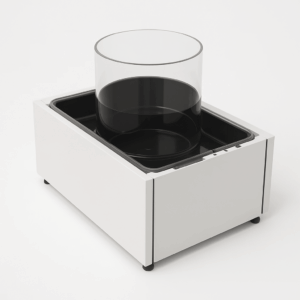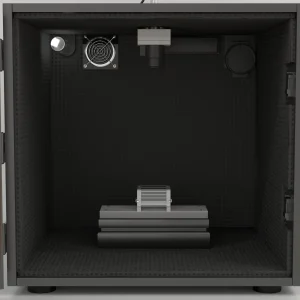$8,995.00
Thermal withdrawal latency was first introduced by Hargreaves et al. (1988) as a standard method for assessing responses to thermal stimuli. In this procedure, a rodent’s hind paw is subjected to a beam of radiant heat delivered through a transparent glass surface, utilizing a plantar analgesia meter. The time taken for the paw to withdraw from the heat stimulus is recorded for both injured and uninjured hind paws.
The Hargreaves Plantar Test apparatus consists of an emitter/detector unit managed by a controller that adjusts the heat intensity, a glass panel, and various animal enclosures that differ in size based on the species being tested. The entire setup is typically elevated on a platform to facilitate the positioning of the emitter/detector unit.
The infrared (I.R.) heat intensity of this plantar test device can be fine-tuned in increments, generally calibrated to achieve an average paw withdrawal latency of around 10 seconds in rats.
MazeEngineers provides the Plantar Test Hargreaves Apparatus for research applications.

MazeEngineers offers custom-built behavioral mazes at no extra cost—designed to fit your exact research needs. Eliminate reproducibility issues from poor sizing or lingering scent cues with precision-engineered, modular, and smart mazes that adapt in real time to animal behavior. Publish new protocols, run adaptive experiments, and push the boundaries of behavioral science.



Plantar Test |
Controller Unit |
Touch-screen monitor |
Movable Infrared Source |
Dimensions: (L) 62 cm x (W) 21 cm x (H) 20.2cm |
Focused radiant heat light source (controlled by the controller unit) |
Acrylic animal enclosures (support 1 or 2 or 3 units – each unit containing 4 compartments for mice or 2 compartments for rats) |

The Hargreaves Plantar test was first introduced in 1988 by Hargreaves and his colleagues (Hargreaves et al., 1988) as a method for evaluating cutaneous hyperalgesia induced by thermal stimulation in rats. This test is specifically designed to assess thermal pain sensations in designated areas of the plantar surfaces of animals. It has become a widely used tool for examining pain sensitization and responses in subjects recovering from neural injuries and during regeneration. Other apparatuses and assays similar to the Hargreaves Plantar test include the Tail Flick test, Hot-Cold Plate test, and Thermal Gradient test.
The Hargreaves apparatus features chambers with glass flooring where the subject is placed, and a radiant or infrared heat source is directed at the center of the plantar surface from beneath. Each test typically lasts no longer than 35 seconds to prevent tissue damage and ensure the safety of the animals. To maintain the integrity of the heat stimulus, any urine must be cleaned up during trials. The glass flooring reduces heat-sink effects, allowing for more precise application of heat. Unlike other thermal stimulus assessments, the Hargreaves test does not heat the entire plantar surface, thus avoiding the potential confounding effects of heating irrelevant areas and ensuring a more accurate response from the subject.
The Hargreaves Plantar test apparatus consists of an emitter/detector unit, which is regulated by a controller that adjusts the heat intensity. It includes a glass panel and animal enclosures, with sizes tailored to the specific species being tested. For mice, the typical enclosure dimensions are 10 x 10 cm with a height of 15 cm. The entire setup is generally elevated on a platform to facilitate the positioning of the emitter/detector unit.
Before beginning the experiments, the apparatus must be thoroughly cleaned. The performance can be recorded and observed using a tracking and recording system such as the Noldus EthoVision XT or ANY-Maze
Carefully place the subject in its designated compartment on the Hargreaves test apparatus. Provide a minimum of 30 to 60 minutes for the subject to explore the environment. Repeat this habituation process for at least two days prior to conducting the Hargreaves test. To facilitate acclimatization, you can include food or sucrose pellets within the compartments.
Position the subject in its compartment and allow it to acclimate for 15 to 20 minutes. After setting the desired infrared intensity, align the emitter/detector unit directly beneath the center of the paw being tested. Start the timer and the infrared light simultaneously, observing the subject for any pain-related behaviors until the predetermined cut-off time (typically between 20 to 35 seconds) is reached. Conduct additional trials as needed, ensuring a minimum inter-trial interval of 5 minutes. Behaviors such as licking or shaking of the stimulated paw indicate pain responses.
O’Brien et al. (2013) explored whether Nf1 heterozygosity led to heightened pain and itch behaviors in mice. In their study, they utilized male Nf1+/− and wild-type littermates aged seven to ten weeks. Each subject was placed on a pre-warmed glass plate (approximately 30°C) within their individual chambers. A radiant heat stimulus was applied at an active intensity of 17% of the maximum for a duration of 20 seconds. The following day, the subjects received an injection of an inflammatory mediator, and withdrawal latencies were recorded at hourly intervals by averaging two measurements for each paw during that hour. The analysis of the data indicated that Nf1 heterozygosity did not significantly affect pain intensity in the subjects.
Data obtained from the Hargreaves test is clear and concise. Withdrawal latencies, which represent the time taken for the paw to withdraw in response to heat, along with the average reaction time, are documented. It’s crucial to differentiate between reflexive behaviors and voluntary actions. If any ambiguous behaviors are noted, the experiment should be repeated to accurately record the withdrawal latency.
The Hargreaves test assesses the thermal nociceptive responses of the subject. Unlike the Hot Plate test, which exposes the entire plantar surface to heat, the Hargreaves test applies a focused heat stimulus to a specific point on the plantar surface. This approach allows for unilateral response evaluations. The apparatus is user-friendly and straightforward, featuring a compartmentalized design that accommodates multiple subjects simultaneously. The glass bottoms of the compartments help reduce errors associated with heat sink effects. The Hargreaves test is commonly utilized in research on neural injuries and regeneration to assess pain sensitization and recovery of thermal pain responses.
When conducting tests using the Hargreaves apparatus, it is crucial to clean the device before and after trials, as well as during them if necessary, since urine can alter the temperature of the heat stimulus. Observers must carefully distinguish between voluntary and reflexive behaviors; if voluntary actions are noted, the experiment should be repeated to ensure accurate measurements. Additionally, it’s vital to adhere to the cut-off time to avoid causing unnecessary harm to the animals.
Depending on the species and strains used, longer habituation and acclimation periods may be needed, particularly for those with a strong exploratory instinct. Experiments should be carried out while the subjects are awake, and efforts should be made to minimize external stimuli in the testing area to lessen their impact on performance. Furthermore, the Hargreaves test does not provide direct measurements of paw withdrawal temperatures. Consistency in handling and the surgical process can also affect the subjects’ withdrawal responses.
| monitor | |
|---|---|
| Power | 0W-100W, adjustment 1W stepwise 5-100% |
| Power Supply | AC 220V±5% |
There are no questions yet. Be the first to ask a question about this product.
Monday – Friday
9 AM – 5 PM EST
DISCLAIMER: ConductScience and affiliate products are NOT designed for human consumption, testing, or clinical utilization. They are designed for pre-clinical utilization only. Customers purchasing apparatus for the purposes of scientific research or veterinary care affirm adherence to applicable regulatory bodies for the country in which their research or care is conducted.